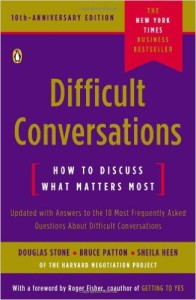“Difficult Conversations: How to Discuss What Matters Most” by Douglas Stone, Bruce Patton, and Sheila Heen are from the Harvard Business School, of all things!
But that is precisely why we can benefit from listening to what they have to say.
Let me explain.
We can be sloppy with how we talk to our loved ones. We feel we have to be “honest,” right? And then what happens? Well, I don’t have to tell you: It generally doesn’t work out so well.
But business! Ah, that’s a different thing. When money is on the table, everyone wants to be careful. Not only careful as in “diplomatic,” but careful as in “getting the outcome that I want.”
Yeah, in business, we are usually smart. If we want to make a sale, we nurse the customer. But with our families, we are just as liable to shoot ourselves in the foot, unfortunately.
So what can these three people tell us about conversations that we didn’t already know?
A lot, apparently. I have to tell you *I* was impressed because they break down conversations even more than I thought I did. (Yup. That’s right. I don’t have to have a big ego about this.)
As a manual of how to work with people — or your family — it is great. Let me give you a bunch of great examples, pages I dog-eared just for you.
“When Blame Is the Goal Understanding Is the Casualty” (p. 64)
“Even in situations that require a clear assignment of blame, there is a cost. Once the specter of punishment – legal or otherwise – is raised, learning the truth about what happened becomes more difficult . . . ‘Truth commissions’ often are created because of this trade-off between assigning blame and gaining an understanding of what really happened. A truth commission offers clemency in return for honesty. . .
“When the dog disappears, who’s to blame? The person who opened the gate or the one who failed to grab her collar? Should we argue about that or look for the dog? . . .
“Using the blame frame makes conversations more difficult, while understanding the contribution [of each person] makes a difficult conversation easier and more likely to be productive.”
Don’t Use Blame As “a Proxy For Your Feelings”
“Sharing your feelings is essential” (p. 68) but that doesn’t mean blame is the same thing as sharing your feelings. It is not.”
Blame is saying, “‘You are responsible for ruining our marriage! How could you do something so stupid and hurtful!?'”
“Speaking more directly about your strong feelings [could be] ‘I feel devastated by what you did’ . . . If you find yourself mired in a continuing urge to blame, or with an unceasing desire for the other person to admit that they were wrong, you may find some relief by asking yourself: ‘What feelings am I failing to express?’ and ‘Has the other person acknowledged my feelings?'” (p. 69)
“Making a specific request for how the other person can change their contribution in the service of helping you change yours can be a powerful way of helping them understand what they are doing to create and perpetuate the problem” (p. 82).
“We Try to Frame Feelings Out of the Problem” (p. 86)
They are saying we would like to avoid expressing our true feelings for fear of making things worse. However, when the feelings are an important part of things, we better not leave them out because that will make things worse.
“Unspoken feelings can color the conversation in a number of ways. They alter your affect and tone of voice. They express themselves through you body language or facial expression. They may take the form of long pauses or an odd and unexplained detachment. You may become sarcastic, aggressive, impatient, unpredictable, or defensive” (p. 88)
The authors go on to explain how to “negotiate with your feelings” (p. 100) that is, talk to yourself: do I really have all the facts? Can I explain this person’s behavior another way? etc.
“Complexify Your Identity (Adopt the And Stance” (p. 118)
The authors are saying that an awful lot of difficult conversations occur because we feel as though our vulnerabilities are being attacked. In order to fix this problem, it is good to see yourself as a more complex person than just “good” or “bad.” As they say, “no one is always anything” (p. 118)
Sometimes, “we trigger their identity conversation” when we have difficult conversations. In other words, we also have to be careful how we say things because the other person may feel their identity is being attacked. “Our story invariably (though often unintentionally) communicates a judgment about them — the kind of person they are — and the fact that inside our version of the events, they are the problem” (p. 148).
“Don’t Make Statements Disguised as Questions” (p. 172)
“‘Are you going to leave the refrigerator door open like that?’ (Instead of ‘Please close the refrigerator door’)
“Acknowledge Their Feelings” (p. 180)
“Like free radicals feelings wander around the conversation looking for some acknowledgment to hook onto. They won’t be happy until they get it and nothing else will do. . . And if you provide that acknowledgment, you give the other person and the relationship something quite precious, something, perhaps, that they can only get from you.”
For those of you who have bought my course, you will see quickly why I endorse this book. It expands on my assertive sheet and can be applied to just about anyone having a difficult conversation.

